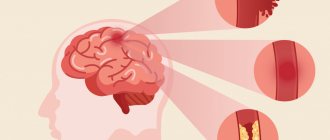Why do my legs and arms go numb? What diseases can lead to these symptoms? Which doctor should I contact? How to diagnose the cause?
Numbness in the arms and legs is a neurological symptom that most often indicates damage, inflammation, or compression of sensory nerves. Often, numbness is accompanied by pain and unpleasant sensations such as tingling and “crawling goosebumps.” Many nerves are mixed, that is, they contain both sensory and motor fibers. In such cases, numbness is combined with a decrease in muscle tone and impaired movement.
There are many reasons for numbness in the limbs. Most often they are associated with pathological processes in peripheral nerves. The larger the nerve, the larger part of the limb loses sensation. In rare cases, the symptom is caused by disorders of the brain and spinal cord.
Numbness from compression of nerves and nerve roots
One of the most common conditions that leads to compression of the nerve roots is intervertebral hernia. Most often it forms in the lumbar spine, as it experiences the heaviest loads. Fortunately, in most cases, if you consult a doctor in a timely manner, intervertebral hernias can be treated without surgery.
Carpal tunnel syndrome leads to numbness, tingling in the hand and other symptoms. In the wrist area there is a tunnel formed by bones and ligaments. It contains a nerve that, under certain conditions, can be compressed.
In the area of the shoulder girdle and collarbone is the brachial nerve plexus - all the main nerves innervating the arm depart from it. During injuries (most often road accidents), these nerves are stretched and compressed, resulting in numbness and, in severe cases, paralysis of the arm.
With spondylolisthesis, the upper vertebra “slips” a little from the lower one, this leads to compression of the spinal cord and nerve roots, and sensitivity disorders.
Causes
Numbness can be a sign of a wide range of diseases or conditions that involve restricted blood flow or nerve damage.
Temporary numbness can be caused by any activity that puts prolonged pressure on the nerve(s), such as sitting cross-legged or cycling long distances. Numbness can also occur due to moderate to severe orthopedic or vascular pathology, as well as conditions and diseases that lead to damage to the nervous system. In some cases, numbness is a symptom of a life-threatening condition that requires emergency medical attention.
Cardiovascular causes of numbness
Numbness can be caused by a lack of blood flow to a certain area due to conditions such as:
- Arteriovenous malformations
- Buerger's disease
- Deep vein thrombosis (a blood clot in the legs can break off, which can lead to pulmonary embolism in the lungs, heart attack, stroke)
- Frostbite
- Diseases of peripheral arteries (vascular atherosclerosis, in which narrowing of the arterial bed occurs).
- Raynaud's syndrome, in which persistent spasm of peripheral vessels occurs and blood circulation in the distal extremities is impaired. Vasospasm is usually triggered by cold or sometimes stress.
Orthopedic causes of numbness
Numbness may also occur due to minor or serious orthopedic conditions that cause nerve damage:
- Whiplash neck injury
- Bone fractures
- Carpal tunnel syndrome
- Degenerative diseases of the intervertebral disc
- Herniated disc
- Compression pinched nerve
- Osteoporosis
Neurological causes of numbness
Numbness due to nerve compression or nerve damage may be due to conditions such as:
- Alcoholism
- Brain tumors
- Diabetic neuropathy
- Encephalitis
- Heavy metal poisoning such as lead poisoning
- Hypothyroidism
- Multiple sclerosis
- Peripheral neuropathy
- Spinal cord injury or tumor
- Stroke
- Systemic lupus erythematosus
- Myelitis
- Myelopathy
- Vitamin B12 deficiency
Numbness during pregnancy
Pregnant women face many changes in the body, and numbness is one of them. Some pregnant women develop carpal tunnel syndrome and it is believed to be due to water retention in the body during pregnancy.
As the fetus develops, fluid accumulates in the body, tissues swell, including in the wrist area, compression of the median nerve occurs and carpal tunnel syndrome develops. Symptoms of carpal tunnel syndrome are more pronounced in the morning hours, as fluid accumulates in the body at night. As a rule, carpal tunnel syndrome in pregnant women heals on its own after delivery.
Numbness in children
There are many reasons why children may experience numbness in different parts of the body. Eating disorders, lack of vitamins and minerals can cause numbness in the lower extremities, this is especially typical for a deficiency of B vitamins. Sports injuries can also cause numbness. Therefore, in childhood, parents need to pay attention to children’s complaints of numbness, which lasts more than a few minutes and may be a sign of damage to ligaments, tendons or bone fractures. Often, anxiety in childhood can be a source of numbness in the lips and face.
Vascular disorders
One of the complications of diabetes is diabetic neuropathy, damage to sensory, motor and autonomic nerves as a result of impaired blood flow in small vessels. One possible symptom is numbness in the limbs.
There is a large group of diseases - vasculitis. Autoimmune inflammation develops in the vessel wall, it thickens, becomes weakened, and scarring occurs. In the lumen of the vessel, areas of narrowing appear in which blood flow is disrupted. Various organs, including nerves, can suffer from this.
With one of the systemic connective tissue diseases - Raynaud's disease - a spasm of the small vessels that supply blood to the fingers and toes occurs. In response to cooling or stress, a feeling of coldness and numbness occurs in the fingers.
Manifestations of finger paresthesia
With paresthesia, numbness, slight tightness of the fingers, and sometimes tingling are felt. Impaired sensitivity prevents you from grasping small objects or performing precise work with your fingers. Based on these signs, it is difficult to make a preliminary diagnosis, however, numbness in some diseases affects only certain fingers:
- Numbness in the little finger of the left hand, as well as the appearance of similar changes in the ring and middle fingers, can be caused by pathologies of the heart and blood vessels. Paresthesia is more pronounced at night;
- Numbness of the fingers of one hand that spreads to the hand occurs during a stroke. In the acute phase of cerebrovascular accident, coordination of movements is also impaired, consciousness becomes confused, and there may be paralysis of one side of the face;
- Numbness of the thumb, index and middle fingers on one of the hands or on both at once is one of the symptoms of compression of the nerves in the spine with osteochondrosis of the neck;
- Paresthesia of the thumb and index finger is a characteristic sign of carpal tunnel syndrome;
- Simultaneous numbness of the fingers on the lower and upper extremities often worries patients with diabetes.
If you complain about numbness, you can initially contact your GP. After examination and clarification of other symptoms of deterioration in well-being, the doctor refers you for examination to specialized specialists - a neurologist, cardiologist, endocrinologist, surgeon.
Diseases of the brain and spinal cord
One of the most common causes of numbness in different parts of the body associated with brain damage is a stroke, as well as a transient ischemic attack, which is popularly called a “mini-stroke”. Severe injuries to the brain and spinal cord can lead to sensory impairment.
Less common are such lesions of the central nervous system as an aneurysm (a pathologically enlarged, weakened area) of a cerebral vessel, arteriovenous malformation (incorrect communication between an artery and a vein, when blood is discharged directly, bypassing the network of capillaries), tumors of the brain and spinal cord, paraneoplastic syndrome ( damage to the nervous system caused by a tumor that is located outside the brain).
The article lists only the main common causes of numbness in the arms and legs. There are others. In order to get an accurate diagnosis and begin proper effective treatment, you need to visit a doctor.
Preventing finger numbness
As with most neurological diseases, preventive measures boil down to the following:
- Maintain an active lifestyle. Do exercises and don’t forget about daily physical activity;
- Listen to your body and undergo timely medical examinations to identify pathology at an early stage;
- Periodically get tested and undergo examination of the vascular system;
- Try to eat healthy and balanced. Don't forget to take your vitamins.
The main thing to remember is that the body always warns in advance about changes, and does not suddenly get sick. Few people notice problems that are just beginning; most often they do not pay attention to it, hoping that everything will go away on its own. Lack of time, fear of doctors and injections, reduction of the importance of what is happening ultimately lead to the disease becoming much worse, treatment time taking much longer, or the consequences can cost lives.
Who should I contact?
A neurologist is involved in the diagnosis and treatment of neurological disorders, such as sensory loss and numbness in the extremities. In order to correctly assume what was the possible cause and choose the right direction of the diagnostic search, the neurologist must examine the patient, find out in which parts of the body numbness occurs (only in the fingers, in the hands or feet, in the entire arm or leg, in one limb , or right and left symmetrically), are there any other neurological symptoms or concomitant diseases.
Depending on the results of the examination, the neurologist may refer you to other specialists:
- For vasculitis, Raynaud's disease - see a rheumatologist.
- For cardiovascular pathologies, see a cardiologist.
- For diabetes mellitus, see an endocrinologist.
- In case of tumors or injuries, see a neurosurgeon.
- For infectious diseases - see an infectious disease specialist.
- In case of poisoning with harmful substances at work, contact an occupational pathologist.
Treatment
For each patient, treatment is developed individually based on diagnostic results and detected diseases. In most cases, they begin by prescribing conservative therapy appropriate to the situation. It may include medication, physical therapy and exercise therapy.
Drug treatment may include drugs from different groups. They are selected based on the causes of numbness in the fingers, but they must take into account concomitant diseases, age and other characteristics of the patient. Typically used:
- NSAIDs - prescribed during an exacerbation of neuropathy to reduce the intensity of pain and eliminate swelling of soft tissues;
- corticosteroids - indicated for severe inflammatory processes, as well as complex neuropathy;
- B vitamins - used to improve the transmission of bioelectric impulses along nerve trunks;
- antiplatelet agents - prescribed to reduce blood viscosity and improve blood circulation;
- calcium antagonists - used to increase the lumen of blood vessels, which is indicated for Raynaud's syndrome;
To increase the effectiveness of drug treatment, physiotherapeutic procedures are often used. The most effective for neurological disorders are:
- electrophoresis;
- phonophoresis;
- laser therapy;
- UHF;
- electromyostimulation;
- applications with paraffin;
- ozocrete treatment;
- mud therapy.
To eliminate numbness, an individually developed complex of exercise therapy must be prescribed. It helps to develop the joints of the hands, activate blood circulation and relieve muscle tension. As a result, tissue trophism and innervation of the fingers improves. But exercise therapy should be done systematically, devoting the proper amount of time to gymnastics every day.
Examination for numbness of extremities
- Depending on the suspected cause of numbness in the limbs, the doctor may prescribe different types of diagnostics. X-rays help diagnose diseases associated with disorders of the skull and spine, such as intervertebral hernia. If there is a suspicion of vascular pathology, angiography is performed - an X-ray examination with the introduction of a contrast solution into the vessels.
- If necessary, you may be prescribed other imaging methods: ultrasound, CT, MRI.
- In order to check in which nerves the conduction of impulses is impaired, electroneuromyography is used - a study using special electrodes.
- Sometimes they resort to the method of evoked potentials. Special sensors are placed on the patient's head to record brain activity. The affected nerve is stimulated through the skin using electrical impulses and the brain is observed to respond to the stimulation.
Since dozens of different reasons can lead to numbness in the arms and legs, the diagnostic program must be individual for each patient. In some pathologies, if left untreated for a long time, even more serious, irreversible neurological disorders may occur. Visit a neurologist, make an appointment by phone: +7 (495) 120-08-07
What is the body saying?
Suddenly my fingers lost sensitivity. If this is a rare phenomenon and it disappears after 2 - 3 minutes, then there is nothing to fear. If such sensations bother you often, then this is a signal of a developing disease.
- Little finger. Paresthesia indicates chronic heart failure and other cardiac pathologies.
- Forefinger. Goes numb with diabetes, occupational stress, inflammation in the joints.
- Thumb. Metabolic processes in the spine are clearly disrupted. You may feel pain in the forearm and weakness in the arm muscles.
- Middle finger. Raynaud's disease, hernia, articular deformity, osteochondrosis of the 7th vertebra.
- Nameless. Numbness due to the fact that the nerve endings in the bend of the elbow are compressed.
Numbness in the right hand may have the following causes:
- impaired blood flow, pinched nerve due to incorrect position of the limb (for example, during sleep);
- staying in an uncomfortable position for a long time (may be due to the nature of the work, for example, carpal tunnel syndrome);
- frequent carrying of bags, suitcases and other heavy objects;
- long exposure to frost or in a cold room;
- long-term muscle tension of the upper limb.










